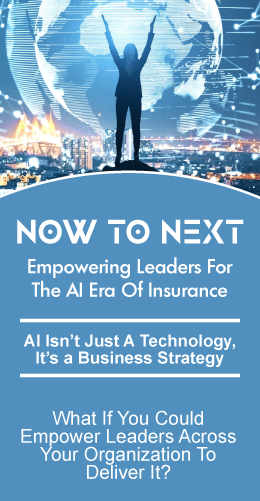
Digital ecosystems are taking over industry after industry, especially those with a focus on products and services. From home buying services to banking to insurance, digital ecosystems are changing the way consumers and companies do business.
A simple example is Intuit, the online financial management software. Intuit makes it easy to connect all of your financial solutions and data together into one easy-to-manage solution. Another example is what John Hancock is doing with their life insurance offering. They offer rewards based on healthy food purchases and activities from wellness trackers such as Fitbits.
Insurance and InsurTech innovators are exploring and harnessing the digital ecosystems that surround and support people, their lifestyles, and stages of life. They are also exploring the digital ecosystems surrounding and supporting industries and the businesses within them. Digital ecosystems are composed of cloud-based interoperable platforms, solutions, devices, and data. The impact of digital ecosystems grows as the solutions within them grow in number, capability, interoperability, and the value they create. The solutions these innovators develop and/or become part of will completely upend the world of insurance.
Auto insurance, health insurance, coverage around businesses, and even life insurance will all be dramatically changed by these tech-forward ecosystem-enabled solutions and will set new standards in the value and the digital experience provided to insurance customers.
Participants across the industry are tapping into these digital ecosystems opening the door to growth and innovation opportunities.That includes InsurTechs and insurance companies. It also includes innovative solution providers like Majesco and other solution providers are developing platform strategies that make it easy for their insurance customers to tap into the data, analytics, and cloud-based insurance solutions that are available within digital ecosystems. This accelerates insurance companies’ and InsurTechs’ ability to modernize and streamline their processes and services and bring innovative solutions to market more quickly.
Digital ecosystems are helping insurance companies, brokers, agents, and InsurTech companies to open up new pathways in order to retain current customers and attract new customers with traditional services, as well as modern products.
Customer Engagement
Digital ecosystems are creating a number of new ways in which companies can connect with and stay in touch with customers. Multiple touchpoints, like mobile devices, wearables, social media, email, artificial intelligence-driven chatbots, and more are literally opening up avenues for companies to create new value and engage with customers. That includes value added solutions that become part of a broader insurance offering such as activity and diet trackers.
What’s more, having access to the data and insights that come back from these devices and solutions helps insurance companies personalize the insurance products and customer experience for individuals and businesses. Competing on a successful level in the future will require that insurers develop new capabilities and an ecosystem of partners that enable data-and-analytics-powered solutions to engage and create value for customers.
Risk Identification
Another major way in which digital ecosystems are changing the insurance industry, as well as the customer-consumer experience, is to help identify risks and gaps in coverage, which in turn will personalize and improve the overall experience for the customer.
New policies that adjust the price or overall coverage in relation to changing risk identifiers are creating incentives to manage risk more directly and actively. Some companies are now producing policies that provide premium credits to people who live a healthier and risk-free lifestyle.
Think about how Progressive Auto Insurance provides discounts and breaks for customers who drive better. The company uses technology known as Snapshot to see how their customer is driving and give them incentives based on their driver safety skills. Innovative insurers are exploring more potential around next-generation policies in other casualty areas to adjust price or coverage and use real-time streams to process claims more accurately and efficiently.
Creating Customer Value with Digital Claims Processes
The ability to tap into the devices, solutions, and data in the digital ecosystem surrounding the end insured is changing the traditional claims management system from an adversarial relationship with the customer to one that actually improves customer loyalty. Using data from devices and other sources, claims can be automatically generated and resolved. Examples of this are emerging in everything from flood to crop to auto to home appliances. The most innovative insurance companies are using these data sources and analytics-driven approaches to automate the entire claims-handling and fraud-detection process.
Chatbot-based systems, for example, are offering customers an automated claims payout process within a matter of seconds. This can be seen in digital native companies like Lemonade, a young startup insurance company that utilizes technology and behavioral science in every aspect of its services. Lemonade works actively with its customers to prevent claims and provide services that add value to customers.
Strategy and Partnering
Insurance companies and InsurTechs (and the tech vendors that support them) that want to succeed in a digital ecosystem market need to develop a culture and strategy that continually evaluates the ecosystems surrounding customers for solutions and data. Doing so will enable them to optimize the value they create and the experience they provide for customers as well as improve the effectiveness of internal processes. Companies like Rein provide insurers and other InsurTechs a next-generation platform and ecosystem that enables companies to bring digital generation insurance solutions that leverage ecosystem solutions and data and machine learning to market faster. From regulatory compliance to risk selection to security features, companies like Rein are helping accelerate the ability of insurance innovators to tap the power and speed of innovation provided by digital ecosystems.
The world of insurance is changing, and doing things the traditional way won’t take companies far enough. With the availability for more digitally-connected data and services and customer experiences, the consumer is demanding products and services that provide them the benefits provided by ecosystem enabled solutions.
Developing a digital ecosystem strategy is a necessity in today’s world. It requires thinking about the customer in a digital world and how the insurer can create value for them by becoming an integral and interoperable part of that world to see how they can successfully support their customers with effective insurance options and services. When this is determined and outlined in an effective way, insurance and InsurTech companies will be able to develop the right strategies and the right partnerships with which to develop products and customer experiences that give them a sustainable competitive advantage.








